Page 275 of 303
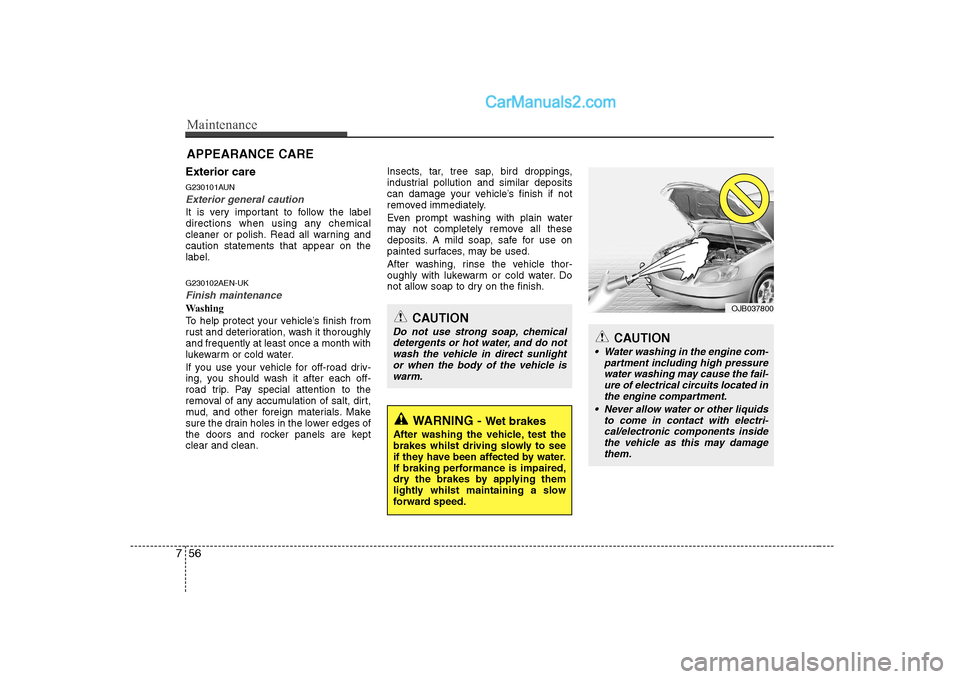
Maintenance
56
7
Exterior care
G230101AUN
Exterior general caution
It is very important to follow the label
directions when using any chemical
cleaner or polish. Read all warning andcaution statements that appear on thelabel. G230102AEN-UK
Finish maintenance
Washing
To help protect your vehicle’s finish from
rust and deterioration, wash it thoroughlyand frequently at least once a month with
lukewarm or cold water.
If you use your vehicle for off-road driv-
ing, you should wash it after each off-
road trip. Pay special attention to the
removal of any accumulation of salt, dirt,
mud, and other foreign materials. Make
sure the drain holes in the lower edges of
the doors and rocker panels are keptclear and clean. Insects, tar, tree sap, bird droppings,
industrial pollution and similar deposits
can damage your vehicle’s finish if not
removed immediately.
Even prompt washing with plain water
may not completely remove all these
deposits. A mild soap, safe for use on
painted surfaces, may be used.
After washing, rinse the vehicle thor-
oughly with lukewarm or cold water. Do
not allow soap to dry on the finish.
APPEARANCE CARECAUTION
Do not use strong soap, chemical
detergents or hot water, and do not
wash the vehicle in direct sunlight or when the body of the vehicle is warm.
WARNING - Wet brakes
After washing the vehicle, test the
brakes whilst driving slowly to see
if they have been affected by water.
If braking performance is impaired,
dry the brakes by applying them
lightly whilst maintaining a slow
forward speed.
CAUTION
Water washing in the engine com- partment including high pressurewater washing may cause the fail-ure of electrical circuits located in
the engine compartment.
Never allow water or other liquids to come in contact with electri-cal/electronic components inside the vehicle as this may damage
them.
OJB037800
Page 282 of 303
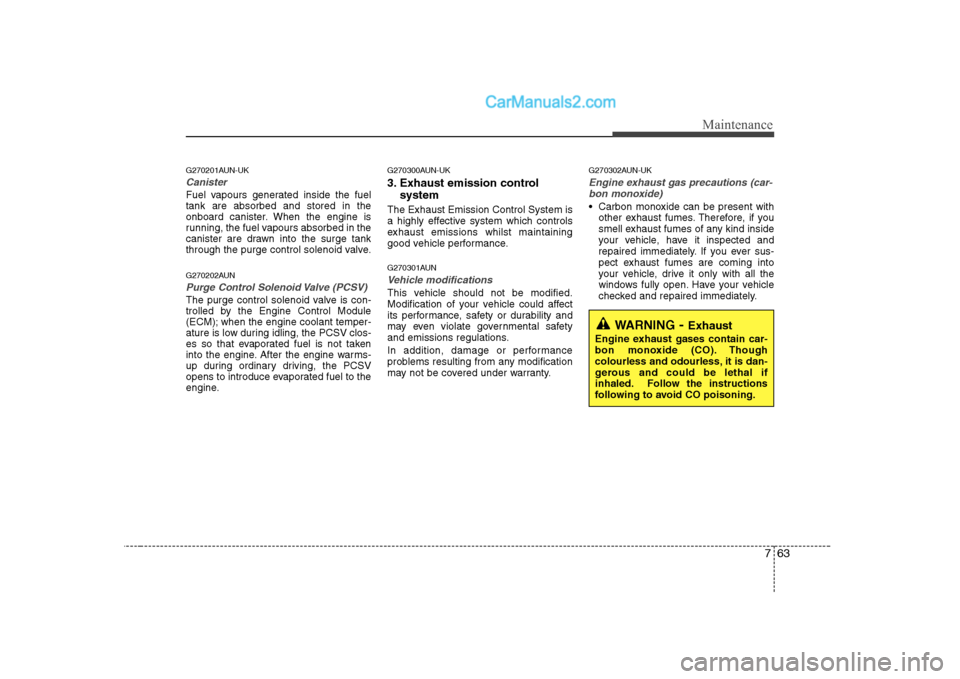
763
Maintenance
G270201AUN-UK
Canister
Fuel vapours generated inside the fuel tank are absorbed and stored in the
onboard canister. When the engine is
running, the fuel vapours absorbed in the
canister are drawn into the surge tank
through the purge control solenoid valve.
G270202AUN
Purge Control Solenoid Valve (PCSV)
The purge control solenoid valve is con-
trolled by the Engine Control Module
(ECM); when the engine coolant temper-
ature is low during idling, the PCSV clos-
es so that evaporated fuel is not taken
into the engine. After the engine warms-
up during ordinary driving, the PCSV
opens to introduce evaporated fuel to the
engine.G270300AUN-UK
3. Exhaust emission control
system
The Exhaust Emission Control System is
a highly effective system which controls
exhaust emissions whilst maintaining
good vehicle performance.
G270301AUN
Vehicle modifications
This vehicle should not be modified.
Modification of your vehicle could affect
its performance, safety or durability and
may even violate governmental safety
and emissions regulations.
In addition, damage or performance
problems resulting from any modification
may not be covered under warranty. G270302AUN-UK
Engine exhaust gas precautions (car-
bon monoxide)
Carbon monoxide can be present with other exhaust fumes. Therefore, if you
smell exhaust fumes of any kind inside
your vehicle, have it inspected and
repaired immediately. If you ever sus-
pect exhaust fumes are coming into
your vehicle, drive it only with all the
windows fully open. Have your vehicle
checked and repaired immediately.
WARNING - Exhaust
Engine exhaust gases contain car-
bon monoxide (CO). Though
colourless and odourless, it is dan-
gerous and could be lethal if
inhaled. Follow the instructions
following to avoid CO poisoning.
Page 283 of 303
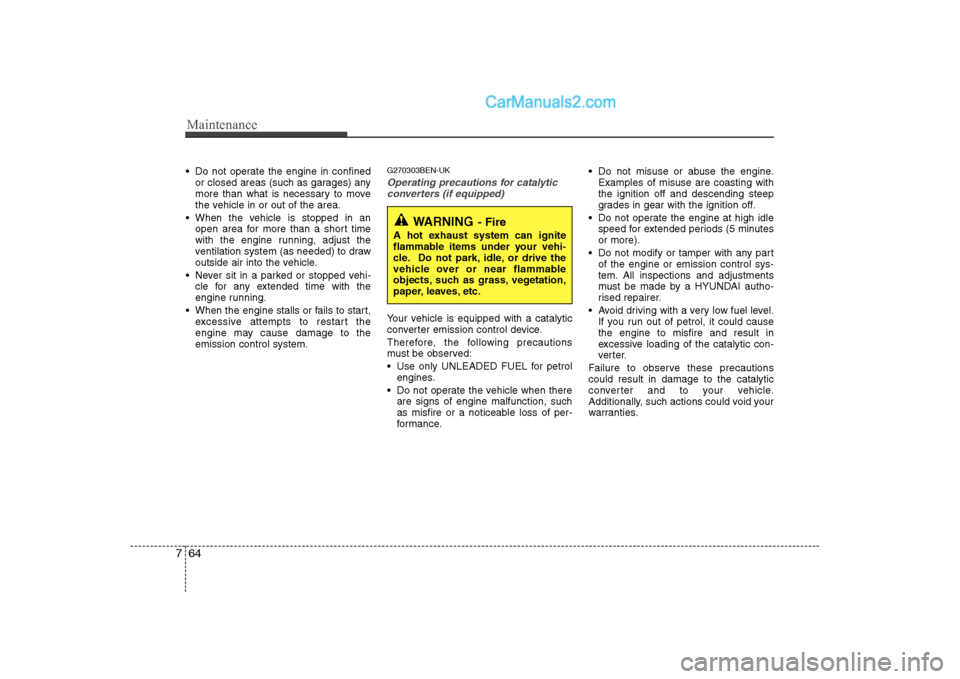
Maintenance
64
7
Do not operate the engine in confined
or closed areas (such as garages) any
more than what is necessary to move
the vehicle in or out of the area.
When the vehicle is stopped in an open area for more than a short time
with the engine running, adjust the
ventilation system (as needed) to draw
outside air into the vehicle.
Never sit in a parked or stopped vehi- cle for any extended time with the
engine running.
When the engine stalls or fails to start, excessive attempts to restart the
engine may cause damage to theemission control system. G270303BEN-UKOperating precautions for catalytic
converters (if equipped)
Your vehicle is equipped with a catalytic
converter emission control device.
Therefore, the following precautions
must be observed:
Use only UNLEADED FUEL for petrol engines.
Do not operate the vehicle when there are signs of engine malfunction, such
as misfire or a noticeable loss of per-
formance. Do not misuse or abuse the engine.
Examples of misuse are coasting withthe ignition off and descending steep
grades in gear with the ignition off.
Do not operate the engine at high idle speed for extended periods (5 minutesor more).
Do not modify or tamper with any part of the engine or emission control sys-
tem. All inspections and adjustments
must be made by a HYUNDAI autho-
rised repairer.
Avoid driving with a very low fuel level. If you run out of petrol, it could causethe engine to misfire and result in
excessive loading of the catalytic con-
verter.
Failure to observe these precautionscould result in damage to the catalytic
converter and to your vehicle.
Additionally, such actions could void your
warranties.
WARNING - Fire
A hot exhaust system can ignite
flammable items under your vehi-
cle. Do not park, idle, or drive the
vehicle over or near flammable
objects, such as grass, vegetation,
paper, leaves, etc.
Page 284 of 303
8
Vehicle identification number (VIN) / 8-2
Vehicle certification label / 8-2
Tyre specification and pressure label / 8-3
Engine number / 8-3
Consumer information
Page 286 of 303
83
Consumer information
TYRE SPECIFICATION AND PRESSURE LABEL
H030000AUN-UK
The tyres supplied on your new vehicle
are chosen to provide the best perform-
ance for normal driving.
The tyre label located on the driver's side
centre pillar gives the tyre pressures rec-
ommended for your car.ENGINE NUMBER
H04000AUN
The engine number is stamped on the
engine block as shown in the drawing.
OTQ087003/H
OTQ087004
B060D01P
Petrol engine
Diesel engine
Page 290 of 303
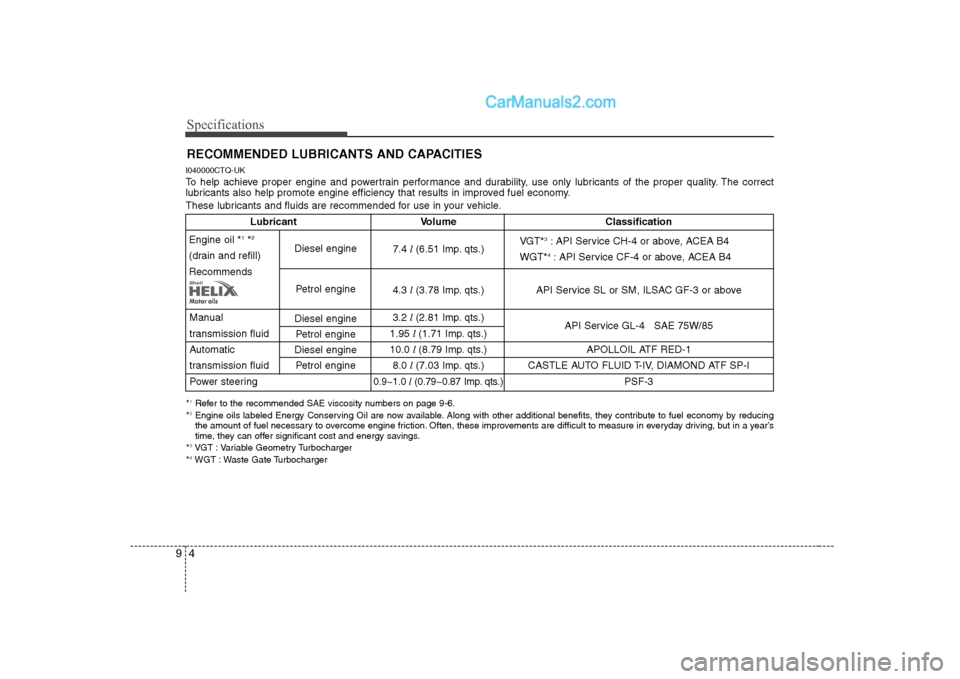
Specifications
4
9
RECOMMENDED LUBRICANTS AND CAPACITIES
I040000CTQ-UK
To help achieve proper engine and powertrain performance and durability, use only lubricants of the proper quality. The correct
lubricants also help promote engine efficiency that results in improved fuel economy.
These lubricants and fluids are recommended for use in your vehicle.
* 1
Refer to the recommended SAE viscosity numbers on page 9-6.
* 2
Engine oils labeled Energy Conserving Oil are now available. Along with other additional benefits, they contribute to fuel econo my by reducing
the amount of fuel necessary to overcome engine friction. Often, these improvements are difficult to measure in everyday driving, but in a year’s
time, they can offer significant cost and energy savings.
* 3
VGT : Variable Geometry Turbocharger
* 4
WGT : Waste Gate Turbocharger
Lubricant Volume Classification
7.4 l (6.51 Imp. qts.)
4.3 l (3.78 Imp. qts.) API Service SL or SM, ILSAC GF-3 or above
Manual 3.2 l (2.81 Imp. qts.)
API Service GL-4 SAE 75W/85
transmission fluid 1.95 l (1.71 Imp. qts.)
Automatic 10.0 l (8.79 Imp. qts.) APOLLOIL ATF RED-1
transmission fluid 8.0 l (7.03 Imp. qts.) CASTLE AUTO FLUID T-IV, DIAMOND ATF SP-I
Power steering
0.9~1.0 l (0.79~0.87 Imp. qts.)PSF-3
Engine oil * 1
*2
(drain and refill) Recommends
Diesel enginePetrol engine
Diesel engine
Petrol engine
Diesel engine
Petrol engineVGT* 3
: API Service CH-4 or above, ACEA B4
WGT* 4
: API Service CF-4 or above, ACEA B4
Page 291 of 303
95
Specifications
Lubricant Volume Classification13 l (11.43 Imp. qts.)
Coolant 10.2
l (8.97 Imp. qts.) Mixture of antifreeze and water
10 l (8.79 Imp. qts.) (Ethylene glycol base coolant for aluminium radiator)
7.1 l (6.24 Imp. qts.)
Brake fluid
0.7~0.8 l (0.61~0.70 Imp. qts.)FMVSS116 DOT-3 or DOT-4
The temperate zone (-30°C ~ 30°C) : API GL-4 (SAE 90)
Rear axle oil1.8~2.4 l(1.58~2.11 Imp. qts.)The torrid zone (30°C ~ ) : API GL-4 (SAE 140)
The frigid zone ( ~ -30°C) : API GL-5 (SAE 80)
Fuel 75 l(16.49 Imp. gal.) -
Diesel engine
Petrol engine
Diesel engine Petrol engineWagon
Va n
Page 292 of 303
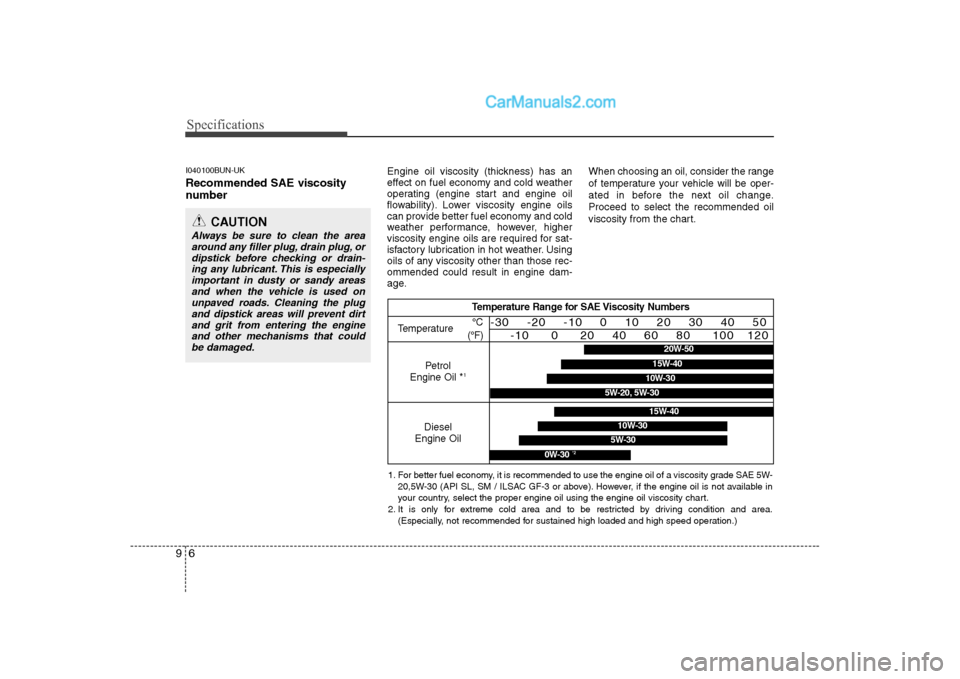
Specifications
6
9
I040100BUN-UK Recommended SAE viscosity
number Engine oil viscosity (thickness) has an
effect on fuel economy and cold weather
operating (engine start and engine oil
flowability). Lower viscosity engine oils
can provide better fuel economy and cold
weather performance, however, higher
viscosity engine oils are required for sat-
isfactory lubrication in hot weather. Using
oils of any viscosity other than those rec-ommended could result in engine dam-
age.When choosing an oil, consider the range
of temperature your vehicle will be oper-
ated in before the next oil change.Proceed to select the recommended oil
viscosity from the chart.
CAUTION
Always be sure to clean the area
around any filler plug, drain plug, or dipstick before checking or drain- ing any lubricant. This is especially
important in dusty or sandy areasand when the vehicle is used on unpaved roads. Cleaning the plugand dipstick areas will prevent dirt
and grit from entering the engineand other mechanisms that could be damaged.
Temperature Range for SAE Viscosity Numbers
Temperature
Petrol
Engine Oil *
1
°C
(°F)-30 -20 -10 0 10 20 30 40 50 -10 0 20 40 60 80 100 120
Diesel
Engine Oil
5W-30
15W-40
10W-30
0W-30 *2
1. For better fuel economy, it is recommended to use the engine oil of a viscosity grade SAE 5W-
20,5W-30 (API SL, SM / ILSAC GF-3 or above). However, if the engine oil is not available in
your country, select the proper engine oil using the engine oil viscosity chart.
2. It is only for extreme cold area and to be restricted by driving condition and area. (Especially, not recommended for sustained high loaded and high speed operation.)
20W-50
10W-30
15W-40
5W-20, 5W-30